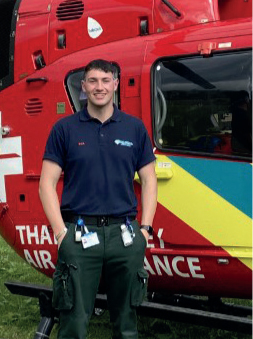
During my summer break, I took up an elective at Stoke Mandeville Hospital in Aylesbury, shadowing an advanced clinical practitioner (ACP) in emergency medicine. I wanted to gain a better understanding of what hospitals do for the patients brought in by the ambulance service and whether it might be something I would consider as a future career. The Royal College of Emergency Medicine allows ACPs from paramedic and nursing backgrounds to access their specialty portfolio, standardising the role of advanced clinical practice in emergency care.
On my first day, I became involved with the Registrar's monthly teaching session, encompassing simulations and case-based discussions (to name only a few of the methods used to develop knowledge and abilities). For the case-based discussions, a member of the team presents an emergency department case, and together, the team would discuss and learn from the elements that went well, and those that did not. Most importantly, staff felt free to discuss limitations in their practice, and this was respected by everyone. It was great to see how connected the team was, as well as the support available within the hospital setting. I learned a lot from the discussion, especially regarding taking accountability and sharing this as part of the learning process. This is just one example of teaching sessions available to the team. There are also mini teaching sessions four times a week at handover, along with junior doctor teaching and an academic half day. These are all brilliant ideas which could be transferred into the prehospital setting, whether that be by trusts via teams or by individual stations.
Some universities accommodate alternative placements like accident and emergency (A&E); however, these are widely used for cannulation practice. From my experience shadowing an ACP, I have benefitted from the other important elements that make up the role of a paramedic, such as history-taking and examination, and linking this to a working diagnosis. While there is absolutely a place for cannulation experience, shadowing the medical team would perhaps be more beneficial, particularly with increasing expectations from the profession.
An important takeaway for me was gaining a detailed social history. This is hugely important to the hospital staff in ensuring a safe discharge. As paramedics, we enter the patient's environment (most of the time) and are very well placed to provide this information to the hospital. The paramedic profession has long evolved from ‘scoop n’ run’ (which was well before my time in this world!)—and although paramedics do not always have the aids to make a definitive diagnosis, we should be aiming for a working diagnosis which the hospital can then build upon. More emphasis should be put on hospital placements with opportunities to shadow ACPs and doctors where paramedics can gain exposure to a broader range of presentations and conditions, knowledge in interpreting arterial blood gases (ABG), electrocardiograms (ECG) bloods and imaging, which are all advanced skills that paramedics can use in various other settings. I also observed the advanced skills an ACP can carry out such as chest drains, suturing and joint reductions.
Lastly, having the option to discuss patients with the consultant was beneficial. Having a senior clinician on hand is a comforting feeling, and is not always about safety-netting. My ACP used the consultant as a senior clinician to understand if they were missing anything from their history and assessment. This could provide an alternative diagnosis or aid referral. Usually the consultant would probe the clinician first to see whether they could answer their own questions and refresh their knowledge before offering guidance. This makes it more of a personal experience incorporating shared decision-making and a solid support structure. Within the prehospital setting, the critical care desk, which has that senior guidance available and is always on hand for support, is an excellent resource for patient discussions.
This experience has helped me understand the process of what happens to the patients we bring into the emergency department. The skills and knowledge that can be gained from a placement shadowing the medical team in A&E can develop better, more autonomous paramedics.

